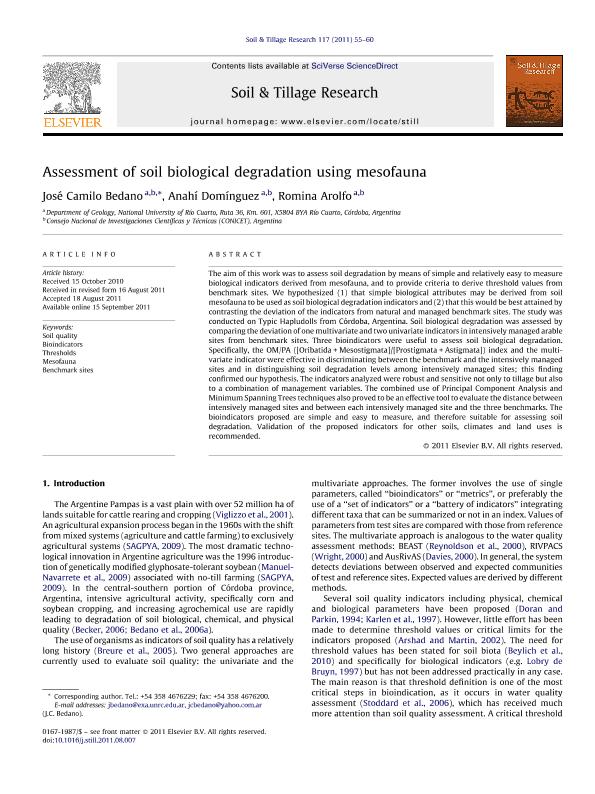Artículo
Assessment of soil biological degradation using mesofauna
Fecha de publicación:
09/2011
Editorial:
Elsevier Science
Revista:
Soil & Tillage Research
ISSN:
0167-1987
Idioma:
Inglés
Tipo de recurso:
Artículo publicado
Clasificación temática:
Resumen
The aim of this work was to assess soil degradation by means of simple and relatively easy to measure biological indicators derived from mesofauna, and to provide criteria to derive threshold values from benchmark sites. We hypothesized (1) that simple biological attributes may be derived from soil mesofauna to be used as soil biological degradation indicators and (2) that this would be best attained by contrasting the deviation of the indicators from natural and managed benchmark sites. The study was conducted on Typic Hapludolls from Córdoba, Argentina. Soil biological degradation was assessed by comparing the deviation of one multivariate and two univariate indicators in intensively managed arable sites from benchmark sites. Three bioindicators were useful to assess soil biological degradation. Specifically, the OM/PA ([Oribatida + Mesostigmata]/[Prostigmata + Astigmata]) index and the multivariate indicator were effective in discriminating between the benchmark and the intensively managed sites and in distinguishing soil degradation levels among intensively managed sites; this finding confirmed our hypothesis. The indicators analyzed were robust and sensitive not only to tillage but also to a combination of management variables. The combined use of Principal Component Analysis and Minimum Spanning Trees techniques also proved to be an effective tool to evaluate the distance between intensively managed sites and between each intensively managed site and the three benchmarks. The bioindicators proposed are simple and easy to measure, and therefore suitable for assessing soil degradation. Validation of the proposed indicators for other soils, climates and land uses is recommended.
Palabras clave:
BENCHMARK SITES
,
BIOINDICATORS
,
MESOFAUNA
,
SOIL QUALITY
,
THRESHOLDS
Archivos asociados
Licencia
Identificadores
Colecciones
Articulos(CCT - CORDOBA)
Articulos de CTRO.CIENTIFICO TECNOL.CONICET - CORDOBA
Articulos de CTRO.CIENTIFICO TECNOL.CONICET - CORDOBA
Citación
Bedano, José Camilo; Domínguez, Anahí; Arolfo, Romina Vanesa; Assessment of soil biological degradation using mesofauna; Elsevier Science; Soil & Tillage Research; 117; 9-2011; 55-60
Compartir
Altmétricas




